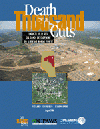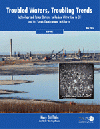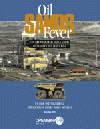


Publications
 All of Pembina's Oil Sands Watch related publications are available here. You can refine your search by clicking Refine Publication Search below. To access Pembina's full directory of publications go to Pembina's publications page.
All of Pembina's Oil Sands Watch related publications are available here. You can refine your search by clicking Refine Publication Search below. To access Pembina's full directory of publications go to Pembina's publications page. Refine Publication Search
Refine Publication SearchOverhauling the Royalty and Tax Treatment of Alberta's Oil Sands
By: Amy Taylor, Marlo Raynolds
Between 1996 and 2005, world oil prices more than doubled and production of the oil sands, spurred on by federal subsidies and low provincial royalty rates, increased by 123%. Amazingly, during the same time period, Albertans, the owners of the oil sand resource, saw their share of this economic boom in the form of royalty revenue decline for each barrel of oil from the oil sands. Albertans received $3.39 in royalties for each barrel of oil sands oil in 1996 and only $2.29 in 2005. At the same time, a federal tax break resulted in up to billions in deferred tax revenue. This report demonstrates that the current tax and royalty treatment of the oil sands is a bad deal for Albertans - the owners of the resource, and Canadians.
Publication Type: Reports, Backgrounders & Position Papers
Topic Area: Oil Sands
Published: Nov 29, 2006
By: Amy Taylor, Marlo Raynolds
This four page summary takes a critical look at the tax and royalty treatment of Alberta's oil sands. An outdated royalty regime and federal tax breaks are costing Albertans and Canadians money in the form of forgone tax and royalty revenues. Between 1996 and 2005, royalty revenue per barrel of oil from oil sands declined 32% and the federal government lost up to $1.65 billion in tax revenue. Albertans as owners of the oil sands need to demand that their resource manager, the Minister of Energy get them a better deal for oil sands developments. And Canadians need to demand that the Federal Minister of Finance eliminate subsidies to a very profitable industry.
Publication Type: Briefing Notes, Summaries & Fact Sheets
Topic Area: Oil Sands
Published: Oct 23, 2006
By: Pembina Institute
The oil sands are projected to contribute up to 47% of the projected business-as-usual growth in Canada's total emissions between 2003 and 2010, making them the single largest contributor to GHG pollution growth. This fact sheet highlights the key findings of Pembina's full report entitled Carbon Neutral by 2020: A Leadership Opportunity in Canada's Oil Sands and provides a sample cost analysis showing how oil sands companies could achieve "carbon neutral" (no net GHG pollution) production for as little as a few dollars per barrel of oil.
Publication Type: Briefing Notes, Summaries & Fact Sheets
Topic Area: Oil Sands
Published: Oct 23, 2006
By: Marlo Raynolds, Matthew McCulloch, Rich Wong
The oil sands are projected to contribute up to 47% of the projected business-as-usual growth in Canada's total emissions between 2003 and 2010, making them the single largest contributor to GHG pollution growth. This report concludes that oil sands companies could achieve "carbon neutral" (no net GHG pollution) production for as little as a few dollars per barrel of oil.
Publication Type: Reports, Backgrounders & Position Papers
Topic Area: Oil Sands
By: Pembina Institute
An Oil Sands Multi-stakeholder Committee was formed to lead a public consultation on the development of oil sands. Seven public input sessions were held across Alberta from September 13 to October 4, 2006 and people from across Canada and internationally were invited to send their concerns by email to the Panel. Pembina experts presented at five of the seven sessions (listed below). This final letter to the Panel summarizes Pembina's presentations (also listed below).
Publication Type: Letters & Formal Submissions, Presentations
Topic Area: Oil Sands
Published: Sep 27, 2006
By: Amy Taylor
Amy Taylor, an economist speaking on behalf of the Pembina Institute makes the case for reforming the oil sands royalty regime to ensure Albertans are fairly compensated for the development of oil sands resources that they own.
Publication Type: Letters & Formal Submissions, Presentations
Topic Area: Oil Sands
By: Marlo Raynolds
The manner in which Alberta's oil sands are developed poses a major risk to our global climate system due its release of greenhouse gas pollution. Also at risk is our international reputation. Marlo Raynolds, presenting on behalf of the Pembina Institute at the Oil Sands Multi-stakeholder session in Edmonton, explains how oil sands operations can become carbon neutral by 2020.
Publication Type: Letters & Formal Submissions, Presentations
Topic Area: Oil Sands
Fort McMurray, Sept 19, 2006
By: Dan Woynillowicz
Satellite images of oil sands mining operations easily illustrate the environmental consequences of oil sands development, deemed by the United Nations Environment Program to be one of the 100 global "hot spots" of environmental change. Dan Woynillowicz, representing the Pembina Institute, highlighted the need for the govenment to rein in the pace of oil sands development and ensure it has the systems in place to protect the environment at the public consultation meetings on oil sands development in Fort McMurray.
Publication Type: Letters & Formal Submissions, Presentations
Topic Area: Oil Sands
Peace River, Sept 14, 2006
By: Simon Dyer
Most of Alberta's oil sands are too deep to mine. Oil must be extracted using other methods that result in a dense network of roads, wells and pipelines throughout the forests of Alberta. Deep oil sands extraction could potentially impact 21% of Alberta. Simon Dyer represented the Pembina Institute at a oil sands consultation meeting in Peace River where he outlined the impacts of and proposed solutions for deep oil sands development.
Publication Type: Letters & Formal Submissions, Presentations
Topic Area: Oil Sands
Bonnyville, September 13, 2006
By: Mary Griffiths
As lead author of the Pembina Institute's report Troubled Waters, Troubling Trends, Dr. Mary Griffiths represented Pembina in the first of a series of province-wide public input sessions on oil sands development. Griffiths highlighted some of the issues relating to the use of fresh water for oil sands extraction.
Publication Type: Letters & Formal Submissions, Presentations
Topic Area: Oil Sands
Published: Aug 23, 2006
By: Dan Woynillowicz
This fact sheet provides an overview of key facts and figures from The Pembina Institute's book Oil Sands Fever: The Environmental Implications of Canada's Oil Sands Rush produced in 2005.
Publication Type: Briefing Notes, Summaries & Fact Sheets
Topic Area: Oil Sands
Published: Aug 1, 2006
By: Simon Dyer
The Pembina Institute's new book Death by a Thousand Cuts: The Impacts of In Situ Oil Sands Development on Alberta's Boreal Forest examines the environmental impacts of in situ (in place) development of deep oil sands that has the potential to affect a forested region 50 times larger than the areas leased for oil sands mining north of Fort McMurray. This document accompanies the report, and provides an overview of key facts and figures.
Publication Type: Reports, Backgrounders & Position Papers
Topic Area: Oil Sands
 Published: Aug 1, 2006
Published: Aug 1, 2006By: Simon Dyer
The Pembina Institute's new book Death by a Thousand Cuts: The Impacts of In Situ Oil Sands Development on Alberta's Boreal Forest examines the environmental impacts of in situ (in place) development of deep oil sands that has the potential to affect a forested region 50 times larger than the areas leased for oil sands mining north of Fort McMurray.
Publication Type: Reports, Backgrounders & Position Papers
Topic Area: Oil Sands
Published: Aug 1, 2006
By: Pembina Institute
Death by a Thousand Cuts is an interactive Flash movie featuring over-flights of the massive oil sands developments in northern Alberta. Shot on the ground and from the air north and south of Fort McMurray, this interactive movie shows and explains the oil sands mining operations north of Fort McMurray and the larger deep oil sands in situ operations from the air. Oil sands mining leases already cover 3,000 km2 of boreal forest; the in situ deep oil sands operations could cover 21 % of Alberta if all leases are sold.
Publication Type: Reports, Backgrounders & Position Papers
Topic Area: Oil Sands
Published: May 30, 2006
By: Simon Dyer
The Pembina Institute commissioned Probe Research Inc., a professional research and survey organization based in Winnipeg, Manitoba, to conduct a study among Alberta adults. The purpose of the study was to gauge public attitudes towards the environmental and economic impacts of oil sands development in Alberta and to ascertain Albertans' understanding and expectations regarding the roles and responsibilities of the public and private sectors involved in oil sands development.
Publication Type: Reports, Backgrounders & Position Papers
Topic Area: Oil Sands
Published: May 30, 2006
By: Simon Dyer
The Pembina Institute commissioned Probe Research Inc. to conduct a study to gauge public attitudes towards the environmental and economic impacts of oil sands development in Alberta and to identify the roles and responsibilities of the public and private sectors involved in oil sands development.
Publication Type: Reports, Backgrounders & Position Papers
Topic Area: Oil Sands
 Published: May 1, 2006
Published: May 1, 2006By: Mary Griffiths, Amy Taylor, Dan Woynillowicz
Oil sands mining and steam injection, to produce oil from bitumen that is too deep to mine, currently use vast amounts of water from rivers and groundwater. Rapid expansion in tar sands production means new technology and policies described in the report must be implemented to reduce water use.
Publication Type: Reports, Backgrounders & Position Papers
Topic Area: Oil Sands
 Published: May 1, 2006
Published: May 1, 2006By: Mary Griffiths, Amy Taylor, Dan Woynillowicz
Oil sands mining and steam injection, to produce oil from bitumen that is too deep to mine, currently use vast amounts of water from rivers and groundwater. Rapid expansion in tar sands production means new technology and policies described in the report must be implemented to reduce water use.
Publication Type: Reports, Backgrounders & Position Papers
Topic Area: Oil Sands
Published: Mar 15, 2006
By: Dan Woynillowicz, Chris Severson-Baker
Down to the Last Drop is the first in a series of issue papers examining the environmental implications of Canada's oil sands operations. The report authors examine Alberta Environment's recently released plan for managing water withdrawals from the Athabasca River and concludes that it does not protect the river from long-term ecological impacts due to oil sands development.
Publication Type: Reports, Backgrounders & Position Papers
Topic Area: Oil Sands
Published: Dec 1, 2005
By: Pembina Institute et al.
Publication Type: Reports, Backgrounders & Position Papers
Topic Area: Oil Sands
Published: Nov 29, 2005
By: Matthew Bramley, Dan Woynillowicz, Derek Neabel
Canada needs to urgently reduce its greenhouse gas emissions if it is to meet its near-term reduction targets as set by the Kyoto Protocol. Against this backdrop of urgent efforts, 28 new GHG intensive projects in Alberta's oil sands are expected to come on stream in the next 10 years. The stark contradiction between the need for deep reductions and rapid oil sands development demands urgent attention.
Publication Type: Reports, Backgrounders & Position Papers
Topic Area: Oil Sands
Published: Nov 23, 2005
By: Pembina Institute
Shot on location in Fort McMurray and Calgary, Alberta, Pembina's production "Oil Sands Fever" presents Oil Sands Fever author Dan Woynillowicz, Gord Lambert (VP of Sustainable Development for Suncor Energy) and Melody Lepine (Director of Industry Relations for the Mikisew Cree First Nation).
Publication Type: Reports, Backgrounders & Position Papers
Topic Area: Oil Sands
 Published: Nov 23, 2005
Published: Nov 23, 2005By: Dan Woynillowicz, Chris Severson-Baker, Marlo Raynolds
Oil Sands Fever: The Environmental Implications of Canada's Oil Sands takes a comprehensive look at the intense development of oil sands occurring in northern Alberta's boreal forest and the environmental consequences. The book concludes with recommendations on how to improve the environmental management of the oil sands.
Publication Type: Reports, Backgrounders & Position Papers
Topic Area: Oil Sands
Published: Nov 23, 2005
By: Pembina Institute
Big, bigger and biggest describes the oil sands in Alberta, Canada. This slide show summarizes the environmental implications of Alberta's oil sands developments as described in the Pembina Institute's new book Oil Sands Fever: the Environmental Implications of Canada's Oil Sands Rush.
Publication Type: Reports, Backgrounders & Position Papers
Topic Area: Oil Sands
In this section |
|
|
| © 1998-2006 The Pembina Institute for Appropriate Development | Privacy Statement | Contact Us |